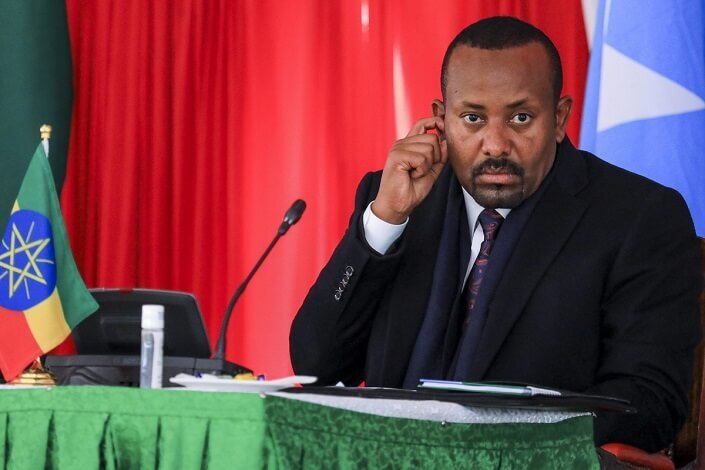 When Abiy Ahmed took power as Ethiopia’s prime minister in April 2018, he was the youngest head of government in Africa.
When Abiy Ahmed took power as Ethiopia’s prime minister in April 2018, he was the youngest head of government in Africa.
At 42, he represented a stark contrast to many ageing African leaders who had been in position for decades. These leaders often stake their claim to power by referring to their victories in revolutionary wars many decades back.
Before Abiy’s entry, Ethiopia had been governed by the same party for 27 years – the Ethiopian People’s Revolutionary Democratic Front. This was a coalition of parties established by the Tigray People’s Liberation Front in 1991. The party claimed legitimacy by pointing to its victory in a civil war in 1991.
It took mass protests from the youth – and an elite split within the government – to overthrow this regime.
After rising to power, Abiy replaced the old ruling party with the Prosperity Party. This, along with his relative youthfulness, was seen as a break with the past.
The hope was that this change would bring the political and economic inclusion of young people in Ethiopia. This category includes those aged 15 to 29, who make up 28% of Ethiopia’s population of 122 million.
This group at the time experienced high unemployment levels and political marginalisation. Little has changed since then.

My co-researchers and I have been investigating regime-youth interactions in Ethiopia, Mozambique, Uganda and Zimbabwe since 2019. By exploring these interactions and the major policies addressing young people, we aim to see whether state policies empower the youth or keep them on the margins.
In Ethiopia, we identified two major policy responses to the youth. The first was job creation. The second was political representation through youth-specific representative bodies.
We found that while these responses are officially meant to address economic and political marginalisation, they have instead been used to repress or co-opt the youth.
We argue that regime strategies towards the youth in Ethiopia – as in the other countries in our study – are part of the “menu” of authoritarian strategies for incumbents to hold on to power.
The research
Our research in the four countries started with the question: are youth agency and regime policy leading to empowerment, or to suppression and old patterns of subordination?
The question was particularly intriguing in the context of Ethiopia, where youth-dominated protests were instrumental in bringing Abiy to power.
Recognising this, Abiy and his allies promised to address the demands of the youth for inclusion. This naturally created high expectations.
But more than four years after this promise, the situation for Ethiopia’s large youth population looks bleak. It’s arguably even more so than before. A two-year war in the country’s northern region of Tigray reinforced ethnic divisions and created a humanitarian crisis. Unemployment rates are still high and the youth are still being mobilised for political ends.
Employment schemes, such as the Youth Revolving Fund and Job Creation Commission, have been used as mechanisms to silence and co-opt the youth. Youth protest movements have either been co-opted into the established party machinery or turned into militarised vigilante groups. These became instrumental in the 2020 war in Tigray.
Co-option
Our case study of the Youth Revolving Fund shows that this government scheme failed to create sustainable job opportunities and improve livelihoods.
Introduced at the height of the youth-dominated protest in 2017, the scheme was used to pacify the youth. Consequently, it lacked sufficient capacity and skills training components. Loans were made without proper guarantees for repayment, preventing money from revolving and becoming available to fund new youth projects.
Our study of regime-youth interactions in Oromia and Amhara – the most populous regional states in Ethiopia and home to the youth protests – revealed that the government resorted to co-opting and repressing young people.
In Oromia, Ethiopia’s largest state, material co-option was seen in the distribution of credit, land, rights over resources and even condominium housing.
In Amhara, in north-west Ethiopia, rhetorical co-option was used. The worldview dominant among protesters was ostensibly adopted so as to get their support. Abiy appeared to castigate the country’s federal system and emphasise “national unity”.
We also observed institutional co-option: bringing activists and opposition leaders into government.
Repression
While the immediate post-2018 period saw a decline in repressive tactics, it resumed as the youth started to challenge the Abiy regime.
The Prosperity Party considers Oromia its home base – Abiy is considered an Oromo leader. The party was, therefore, less likely to tolerate dissent in the region. This, coupled with an active insurgency from the Oromo Liberation Army, made Oromia youth exceptionally vulnerable to repression. Arbitrary mass arrests and a crude counter-insurgency resulted in severe human rights violations.
In Amhara, the government resorted to repression as youth protests returned in 2019.
The government relaxed the use of force as it needed the Amhara youth following the outbreak of war in Tigray in 2020. Repression resumed when the government felt the initial threat from the Tigray People’s Liberation Front had been reversed.
Next steps
Co-option and repression weakened and fragmented the youth movements responsible for the anti-government protests of 2014-2018 in Ethiopia.
The war in Tigray – which is currently on pause – also resulted in the heavy militarisation of the youth, especially in the Amhara region.
Our research demonstrates that governments coming to power riding a wave of youth protests can nonetheless resort to authoritarian tactics to neutralise dissent from the same movements. In authoritarian contexts, translating protest gains into genuine political (and economic) gains is an uphill battle.
The alternative is to think strategically about young people’s potential to achieve the “prosperity” the ruling party promises.
We also found that youth employment schemes can be turned into instruments to silence the youth.
Deeper analyses of youth-specific policies should be contextually grounded to reveal possible authoritarian uses beyond official objectives.
The Conversation
